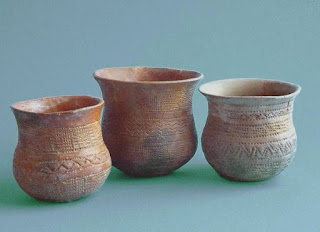The ancient ancestors of the Hjelt family lived in Western Asia at the time of ice age and for long after that. Researchers use the name "refuge" for places of this kind. The present location of their place of residence is shown on the following map: Eastern Anatolia, the south side of the Caucasus mountains, the northern part of Mesopotamia and the southern and eastern coasts of the Caspian Sea. If one describes the area in relation to today's countries, then it would consist of the eastern parts of Turkey, the northern parts of Iraq and Iran, and the western part of Turkmenistan.
About 8.500 BC somewhere in this area there lived a man whose Y-DNA had a special mutation that is known as R1b today. All the sons and male descendants of this man still carry this mutation today. The descendants have been extremely successful as they now comprise a majority of the male population of Western Europe. This very important ancestor was surely unremarkable and not noticed as being in the least bit significant, but for all of his millions of descendants he was indeed a very important person.
The Aurochs Tamers
The early population in the refuge can be described as nomadic breeders of cattle. Earlier, the tribes of the area had been hunters of mammoths and aurochs. After the mammoths became extinct, the aurochs (bos primigenus), wild boar (sus scrofa) and goat were tamed. The population no longer lived a life of nomadic hunting but began the shepherding of the domesticated animals. The two oldest known archeologic findings with signs that cattle-breeding was being practiced are located in eastern Turkey and northern Iraq just where the R1b men's population began to enlarge rapidly about 8.500 BC. As an aside it can be mentioned that DNA tests made of ancient bovines' bone findings show a bottleneck of only 80 individuals in the aurochs population.
The R1b men in the northern region of the refuge belonged to a population which principally bred cattle, but continued to spend at least part of the time leading a nomadic life. These men differed from that population of the southern parts of the area in which people began to practice agriculture and settled down permanently, cultivating the fertile areas of Mesopotamia.
Those who have read Kalevi Wiik's books on origins of the European (2002-06) are perhaps surprised that the view presented in the books deviates totally from the one that has been presented in this article. Ten years ago a common perception was that R1b men's refuge was on the Iberian Peninsula and that the R1b men would have spread out from there to other parts of Europe. That theory was based mainly on the observation that the haplogroups of the present population in which the R1b men are clearly concentrated are in Spain and Portugal. However, during the years 2009 through 2012 four studies were conducted, and this year (2015) two more studies, all of which have lead researchers to entirely different conclusions. These six studies support the conclusion that the R1b men came to Europe from the east 2.000 to 3.000 years later than was previously believed.
Furthermore, in recent years human bones from ancient burial sites have been collected from warehouses of museums around Europe in order to study their DNA. Radiocarbon dating and archeologic studies have been made of them earlier, so the dead persons' culture environment is known but not where their origins are. The results of these studies also strengthen the current perception that the R1b men's refuge was located in the region I previously described.
Exodus
The R1b population in the refuge was divided in the course of time into three parts:
The first branch spread out to the south to the Middle East about 500 years after the development of the R1b mutation. This group is identified as subclade R-V88. Their migration continued still until they reached Central Africa. Today the descendants of these men form more than 60% of male population in North-Cameroon and Chad.
The second branch, R-P297, left for the north by crossing the Caucasus mountains. The warming of the climate to the north of the Caucasus had made the conditions on wide, grassy steppes ideal for cattle breeding. Fairly soon another branch spread out to the east toward the Caspian Sea and into Central Asia (R-M73). An even larger group (R-M269) spread out to the steppes between the Dnepr and the Volga about 5.000 BC. This is the group that I'll follow in my next writings.
However, all the men did not leave their refuge. One genetic branch stayed in Anatolia (R-M335). For some reason it did not succeed there as had other genetic populations. Nowadays some men belonging to this haplogroup live in the areas occupied by Kurds, but they are very rare.
_____
Eupedia Genetics
Wikipedia: Haplogroup R1b
Did R1b cross the Caucasus with cattle?












